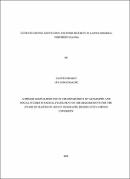| dc.description.abstract | The study was carried out to investigate the effects of climate change adaptations on food security
in Lamwo district. Specifically, it identified climate change trends in Lamwo district, analyzed the
effects of climate change adaptation practices on food availability, access, utilization and stability.
The study was conducted in two sub counties of Agora and Madi Opei that were purposively
selected from the whole district because these two sub counties lie in the little rain corridor hence
experience long dry conditions. There were 375 households who were randomly selected for the
study. The methods used to collect data from the field included documentary review which was
used to collect data on climate change trends ,direct observation which was used to obtain
information about Climate Change Adaptation Practices (CCAPs) in Lamwo. The interview method
was used to collect data on the- relationship between CCAPs and food security. The findings
revealed that there were great variations in the rainfall amounts, number of rain months, rain days
and temperature. Early planting was found to be the most dominant on-farm CCAP with 38.2%
followed by use of new crop varieties by 25.4%, drought resistant crops by 21.6%, small scale
irrigation farming by 7.8% and crop diversification by 6.4%. The mosi dominant off-farm CCAP
was motor cycling with 50%, followed by operation of shops by 25%, brick laying and market
, -ending with I 0%. It also found out that that 1.2% households had inadequate food to eat, 95.7%
had moderate food availability while 3.1 % had adequate food availability. The study revealed that
19.5% households had access to food, 63.2% had moderate access to food and 17.3% had
inadequate access to food. 37.5% households had less dietary diversity, 58.2 % bad moderate
dietary diversity while 4.3 % had great dietary diversity. It also revealed that 5.0% households had
stable food stability while 95% had unstable food stability. The study concluded that adaptation was
better than non-adaptation. It therefore recommended that households should adapt to climate change using the various strategies since in all aspects, adaptation was better than non-adaptation. | en_US |

